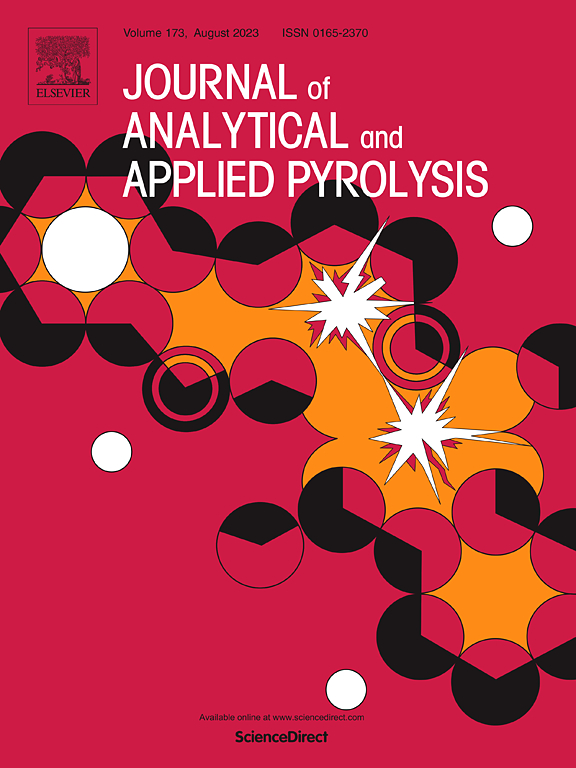微藻特性与其快速热解产物的关联
IF 5.8
2区 化学
Q1 CHEMISTRY, ANALYTICAL
引用次数: 0
摘要
本研究以8种微藻为研究对象,考察了微藻特性、反应温度和热解产物之间的关系。对这些微藻进行了近似分析、终极分析和生化分析。在450-650°C的温度下,使用Pyroprobe®与二维气相色谱仪和飞行时间质谱仪耦合进行快速热解。在所有热解测试中,固体残留物的范围为14.9 - 59.1% %。实验数据集包括24个实例,27个特征,包括微藻组成、温度、生物炭产量和产品组成。本研究采用多变量分析,包括Pearson相关分析、主成分分析(PCA)和典型相关分析(CCA)。Pearson相关分析表明,生物炭产量与灰分、水分呈正相关,与挥发分呈负相关;蛋白质的炭化倾向最高。主成分分析确定了物种特有的产物模式,例如,Arthrospira (Limnospira) platensis与氮化物和芳烃有关,而Odontella aurita尽管含硫量适中,但仍产生含硫化合物。主成分分析还表明,氧和脂类不是芳香形成的关键。CCA揭示了热解温度与芳烃之间的强相关性部分是由于蛋白质含量,并突出了叶绿素含量与酒精产量之间的明显联系。总的来说,这项工作强调了创新微藻作为快速热解原料的潜力,并强调了解释复杂实验数据集的多元工具的实用性和潜力。本文章由计算机程序翻译,如有差异,请以英文原文为准。
Linking microalgae characteristics with their fast pyrolysis products
This study investigated the relationships between microalgal characteristics, reaction temperature, and pyrolysis products using eight microalgal species. Proximate, ultimate, and biochemical analyses were conducted to characterize these microalgae. Fast pyrolysis was performed in a Pyroprobe® coupled to a two-dimensional gas chromatograph and a time-of-flight mass spectrometer at 450–650 °C. The solid residues ranged from 14.9–59.1 % across all pyrolysis tests. The experimental dataset comprised 24 instances with 27 features, including microalgal composition, temperature, biochar yield, and product composition. Multivariate analyses were employed to interpret this dataset, including Pearson correlation analysis, principal component analysis (PCA), and canonical correlation analysis (CCA). Pearson correlation analysis showed biochar yields positively correlated with ash and moisture contents and negatively with volatile matter; proteins exhibited the highest charring tendency. PCA identified species-specific product patterns, e.g., Arthrospira (Limnospira) platensis was linked to nitrogenates and aromatics, while Odontella aurita produced sulfur compounds despite moderate sulfur content. PCA also indicated that oxygen and lipids were not key to aromatic formation. CCA revealed that the strong correlation between pyrolysis temperature and aromatics was partly due to protein content and highlighted a distinct link between chlorophyll content and alcohol production. Overall, this work highlights the potential of innovative microalgae as feedstocks for fast pyrolysis and emphasizes the utility and potential of multivariate tools for interpreting complex experimental datasets.
求助全文
通过发布文献求助,成功后即可免费获取论文全文。
去求助
来源期刊
CiteScore
9.10
自引率
11.70%
发文量
340
审稿时长
44 days
期刊介绍:
The Journal of Analytical and Applied Pyrolysis (JAAP) is devoted to the publication of papers dealing with innovative applications of pyrolysis processes, the characterization of products related to pyrolysis reactions, and investigations of reaction mechanism. To be considered by JAAP, a manuscript should present significant progress in these topics. The novelty must be satisfactorily argued in the cover letter. A manuscript with a cover letter to the editor not addressing the novelty is likely to be rejected without review.

 求助内容:
求助内容: 应助结果提醒方式:
应助结果提醒方式:


